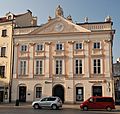Wiśniowiecki
| Wiśniowiecki | |
|---|---|
 | |
| Parent house | House of Zbaraski |
| Country | Polish–Lithuanian Commonwealth |
| Founded | 15th century 1669 Free election |
| Founder | Michał Zbaraski Wiśniowecki |
| Current head | None, Extinct |
| Final ruler | Michael I of Poland |
| Titles | King of Poland Grand Duke of Lithuania Grand Duke of Ruthenia Grand Duke of Prussia Grand Duke of Masovia Grand Duke of Samogitia Grand Duke of Livonia Grand Duke of Smolensk Grand Duke of Kiev Grand Duke of Volhynia Grand Duke of Podolia Grand Duke of Podlasie Grand Duke of Severia Grand Duke of Chernihiv Voivode of Belz Voivode of Ruthenia Koniuszy |



TheHouse of Wiśniowiecki(Ukrainian:Вишневецькі,romanized:Vyshnevetski;Lithuanian:Višnioveckiai) was aPolish-Lithuanianprincely family of Ruthenian-Lithuanian origin, notable in the history of thePolish–Lithuanian Commonwealth.They were powerfulmagnateswith estates predominantly in theRuthenianlands of theCrown of the Kingdom of Poland,and they used thePolish coat of armsofKorybut.
The family is acadet branchof theHouse of Zbaraski.
History
[edit]The family tradition would trace their descent to theGediminids,but modern historians believe there is more evidence for them to have descended from theRurikids.[1]According to the Gediminids relation theory, the ancestor of the family was DukeKaributas(Ruthenian:Dymitr Korybut),[2]a son of theGrand Duke of Lithuania,Algirdas.Kaributas was stripped of the Duchy ofSeveriaand transferred toVolhyniaandPodoliawhere he was given to govern cities ofVinnytsiaandKremenets,andZbarazhas a private estate.[2]At first Zbarazh was inherited by Ivan, but in 1434 it was passed on to the second son of Korybut Fedor ofNieśwież.[2]The latter became a progenitor of such princely families like Porycki, Woronecki, Zbaraski.[2]In the 15th century Wiśniowiecki family split away fromHouse of Zbaraski.[2]
The family place was city of Wiśniowiec (nowVyshnivets).[1][2]At first Wiśniowiecki estates were located predominantly inVolhynia,but since 1580s also included onleft-bank Ukrainein a region aroundLubny,Romny,others that in the past belonged to the princes Glinski and Daumantas.[2]
From their days as Ruthenian nobility, they held the title ofKniaz(prince). By the late 16th century, the family converted fromOrthodoxtoCatholicismand becamePolonized.[1]They gained much importance in thePolish–Lithuanian Commonwealth,with vast possessions in the 16th to 18th centuries on the territories of today'sUkraine,particularly the town ofVyshnivets(Wiśniowiec). Their estates were so vast and their position so powerful that they were known as the most powerful ofmagnates– the "kinglings" or "kinglets" ("królewięta"). Their ancestral seat was theVyshnivets Castle.
The family's golden age was the 17th century, when its members accumulated much wealth and influence, held numerous important posts within the Commonwealth.[1]Likely the most notable members of this family wereMichael I,king of PolandandGrand Duke of Lithuaniafrom 1669 to 1673,[1]his fatherJeremi Wiśniowiecki,as well asDmytro Vyshnevetskywho was an important Cossack leader.
Coat of arms
[edit]The coat of arms of the House of Wiśniowiecki was theKorybut coat of arms.
-
Coat of Arms of KingMichał Korybut Wiśniowiecki
Notable family members
[edit]
- Michał Zbaraski Wiśniowiecki(died after 1516), Prince at Wiśniowiec,progenitor of the Wiśniowiecki family
- Feodor Wiśniowiecki (died in 1533), married Maria ofMoldavia,married secondly Princess Anastasia Zilinska (died after 1535)
- Iwan Wiśniowiecki (died after 1516),courtier,marriedNastazja Olizarowiczh.Chorągwie
- Konstanty Wiśniowiecki(before 1516–1574), courtier, starost ofŻytomierz,married Anna Elżbieta Swierszcz z Olchowca h.Jastrzębiec
- Konstanty Wiśniowiecki(1564–1641),voivode of BelzandRuthenia,married Anna Zahorowska h.Korczak,Urszula Mniszechh. Mniszech,Katarzyna Korniaktownah.KrucyniandKrystyna Strusiównah.Korczak
- Marianna Wiśniowiecka(1600–1624), marriedvoivodeof Bełz and RutheniaMarshalJakub Sobieskih.Janina,the father ofKing of PolandJan III Sobieski
- Janusz Wiśniowiecki(1598–1636),Master of the Stables of the Crown,marriedKatarzyna Eugenia Tyszkiewiczh.Leliwa
- Dymitr Jerzy Wiśniowiecki(1631–1682),Great GuardandHetmanof the Crown,voivode of BelzandKraków,marriedMarianna Zamoyskah.Jelita
- Konstanty Krzysztof Wiśniowiecki(1633–1686),voivode of PodlasieofBracławandBełz,marriedUrszula Teresa Mniszechh. Mniszech and Anna Chodorowska h.Korczak
- Janusz Antoni Wiśniowiecki(1678–1741), voivode ofWilnoand Marshal, marriedTeofilia Leszczyńskah.Wieniawa
- Urszula Franciszka Wiśniowiecka(1705–1753), dramatist and writer, marriedvoivode of Trokiand Hetman PrinceMichał Kazimierz "Rybeńko" Radziwiłłh. Trąby
- Michał Serwacy Wiśniowiecki(1680–1744), thelast male representative of the Wiśniowiecki family,[3]Hetman,CastellanandVoivode of Wilno,Great Chancellor of Lithuania,married Katarzyna Dolska h.Kościesza,Maria Magdalena Czartoryskah.CzartoryskiandTekla Róża Radziwiłłh.Trąby
- Janusz Antoni Wiśniowiecki(1678–1741), voivode ofWilnoand Marshal, marriedTeofilia Leszczyńskah.Wieniawa
- Konstanty Wiśniowiecki(1564–1641),voivode of BelzandRuthenia,married Anna Zahorowska h.Korczak,Urszula Mniszechh. Mniszech,Katarzyna Korniaktownah.KrucyniandKrystyna Strusiównah.Korczak
- Dmytro Vyshnevetsky,also known asBaida,firstAtamanof the UkrainianCossacks,Hetman of theRegistered Cossacks
- Konstanty Wiśniowiecki(before 1516–1574), courtier, starost ofŻytomierz,married Anna Elżbieta Swierszcz z Olchowca h.Jastrzębiec
- Aleksander Wiśniowiecki (c. 1500–1555), starost ofRzeczyce,married Katarzyna Skoruta h. Korczak
- Michał Wiśniowiecki(1529–1584), castellan ofBracławandKiev,married Halszka Zenowiczówna h.Deszpot
- Michał Wiśniowiecki(died 1616),starostofOwrucz,marriedRegina Mohyła
- Jeremi Wiśniowiecki(1612–1651), Prince at Wiśniowiec, Łubny and Chorol,voivode of Ruthenia,marriedGryzelda Konstancja Zamoyskah.Jelita
- Michał Korybut Wiśniowiecki(Michael I, 1640-1673),King of Poland1669–1673, marriedEleanor of Austria, Queen of Poland
- Anna Wiśniowiecka, married starost ofLublinZbigniew Firlejh.Lewart
- Jeremi Wiśniowiecki(1612–1651), Prince at Wiśniowiec, Łubny and Chorol,voivode of Ruthenia,marriedGryzelda Konstancja Zamoyskah.Jelita
- Michał Wiśniowiecki(died 1616),starostofOwrucz,marriedRegina Mohyła
- Aleksander Wisiowiecki (1543–1577), courtier, married Aleksandra Kapusta h. Kapusta
- Adam Wiśniowiecki(c. 1566–1622), married Aleksandra Chodkiewicz h.Kościesza,daughter of HetmanJan Hieronimowicz Chodkiewiczh. Kościesza andKrystyna Zborowskah.Jastrzębiec
- Michał Wiśniowiecki(1529–1584), castellan ofBracławandKiev,married Halszka Zenowiczówna h.Deszpot
Gallery of estates
[edit]-
Manor house inŁodygowice
-
Zbarski Palace inKraków
-
Palace of the Minister of the Treasury inWarsaw(rebuilt from the former Wiśniowiecki Palace)
-
Ruins of the Castle of Biały Kamień
-
Wisniowiecki Chapel (Latin CathedralinLviv)
See also
[edit]References
[edit]- ^abcdeJerzy Jan Lerski; Piotr Wróbel; Richard J. Kozicki (1996).Historical Dictionary of Poland, 966-1945.Greenwood Publishing.p. 654.ISBN978-0-313-26007-0.
- ^abcdefgMytsyk, Yu.Vyshnevetski.Encyclopedia of History of Ukraine.
- ^"Kniaziowie Wiśniowieccy".
External links
[edit]- Lubomyr Wynar.Wiśniowiecki in the Encyclopedia of Ukraine, vol. 5 (1993).
- (in Polish)Herb i rodowód Wiśniowieckich.
- Marek, Miroslav."Genealogy of Wiśniowiecki-Zbaraski family"(in Polish). Genealogy.EU.
- (in Ukrainian)Pictures of Wiśniowiec castle.










